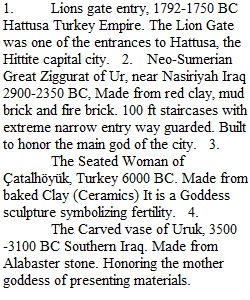


Q Chapter 2 , The Near East 9000 BC - 300 BC This chapter covers the geographical areas of The Tigris and Euphrates rivers including ancient Turkey, Persia, Arabia ,Syria, Iraq, Iran, Azerbaijan, Israel, Jordan, and parts of southern Russia from . This period completes a transition from a nomadic way of life to a communal way of life. The five important developments to recognize during this period are: 1. The development of cities and fortified cities. 2. The proliferation of farming, agricultural irrigation and domesticated livestock. We saw the beginning of this with the later Algerian cave paintings from chapter 1. The move into the Bronze Age and the proliferation of metal tools supports this agricultural advancement. 3 Most important- The creation/invention of writing and the development of written Language to record history, stories and mythologies, religious texts and economic records. This includes Organized/ recorded religion. 4. The introduction of the notion of " the King, or Emperor or Ruler as a deity who presiding over a community of subjects. Think Dungeons and Dragons or Game of Thrones. This notion persists from 5000 BC to 2020 AD and forward... 5. The introduction of music and sports (Ig you consider lion hunting a sport)as a form of entertainment. This implies a time for leisure, a movement away from labor for the sake of survival. One thing to remember is that civilizations are still developing in Egypt, northwest Europe (from chapter 1), the Americas, China and South East Asia, India, Russia, Africa and so on. We can only study on geographical area at a time. From here we move on to look at Egypt. Below are you tube links to 3 video lectures. 1. the Neolithic Era https://youtu.be/vO9XjdlmU0U (Links to an external site.) 2. Akkadians, Sumerian to Assyrian cultures. https://youtu.be/JtTNWCQfys0 (Links to an external site.) 3. Neo Babylonian to Persian cultures. https://youtu.be/yAayaLl04QI (Links to an external site.) 4. Quiz Chapter 2 The Ancient Near East. The Quiz should be treated in the same manner as the first quiz. Provide me with: 1. The name of the object in the picture. 2. The date it was made. 3. The location it was discovered. 4. Describe the objects function of purpose. https://youtu.be/iq-T7588c4k (Links to an external site.) PreviousNext
View Related Questions